Dear foreign readers, you got to try a popular Filipino delicacy called Bagnet when you visit the Philippines. Allow Tita S to tell you 8 facts about it.
1.Bagnet is a deep fried, crispy pork belly dish of the Philippines.
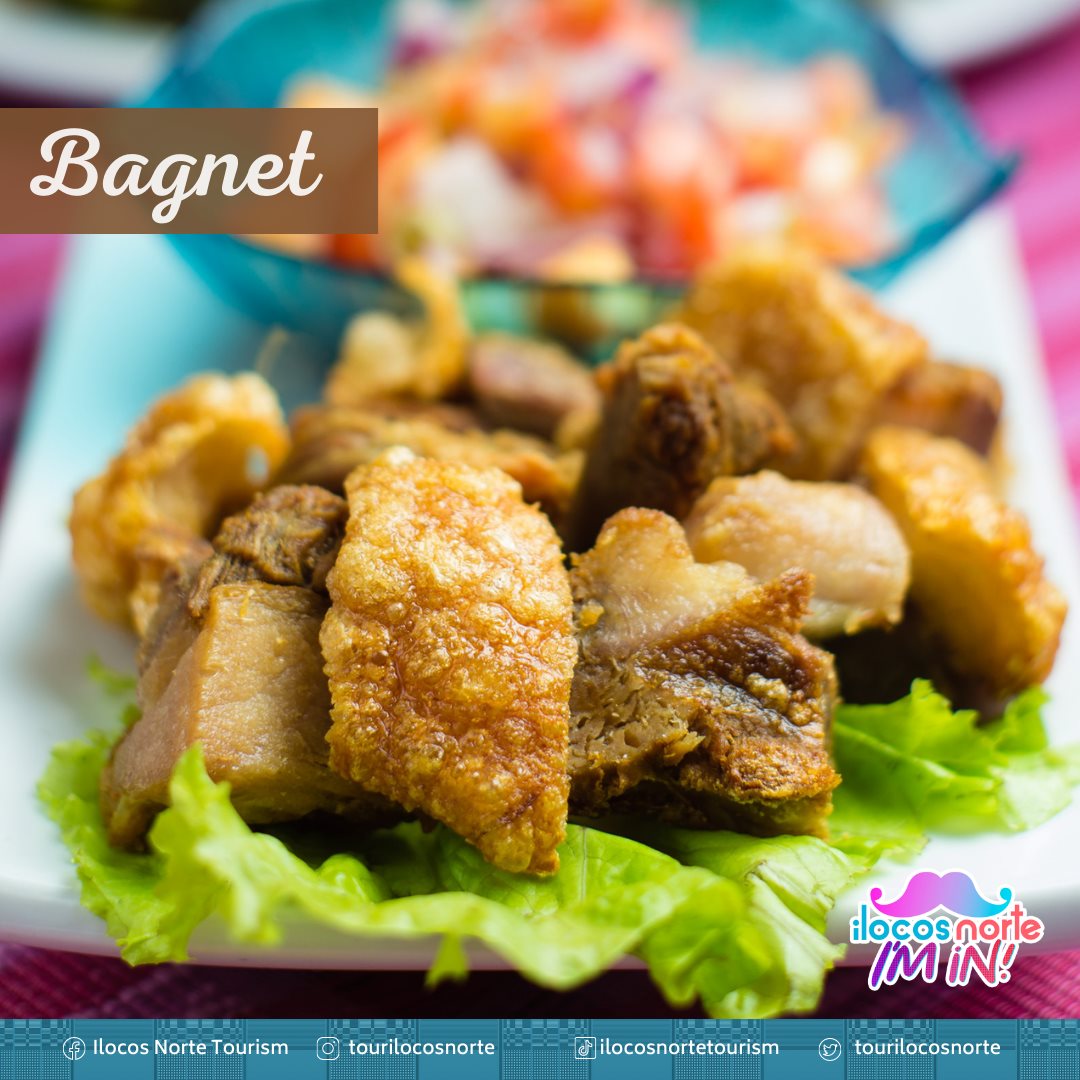
Photo source: https://www.facebook.com/TourIlocosNorte/photos/3562985370444689
2. A slab of pork belly (liempo) is boiled with garlic, black peppercorns, bay leaves and salt. It is then allowed to thoroughly air-dry overnight, then deep-fried the next day, until it becomes crispy. Some rub salt before frying for more flavor. It is deep fried twice to be extra crispy.
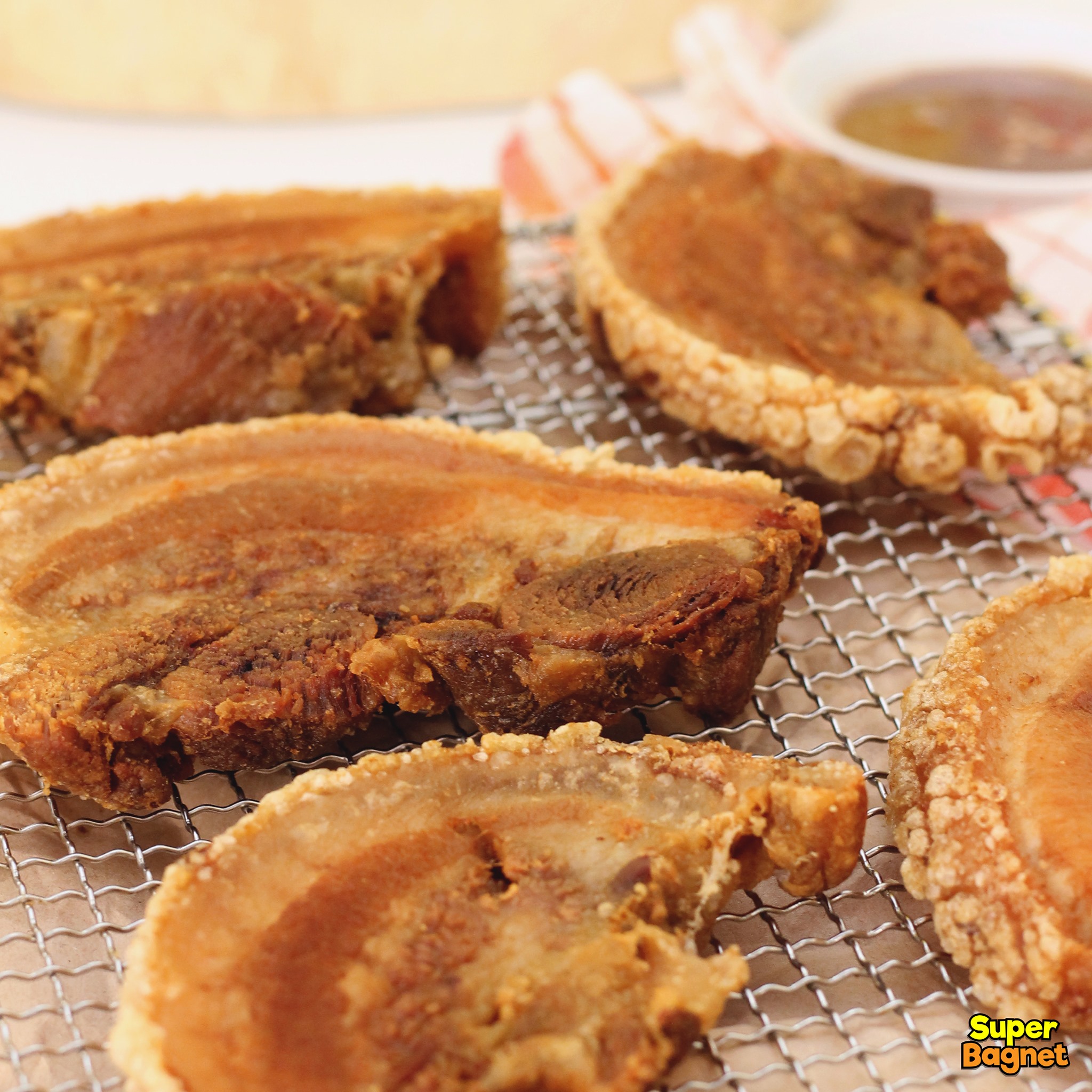
Photo source: https://www.facebook.com/superbagnet/photos/1158292037999358
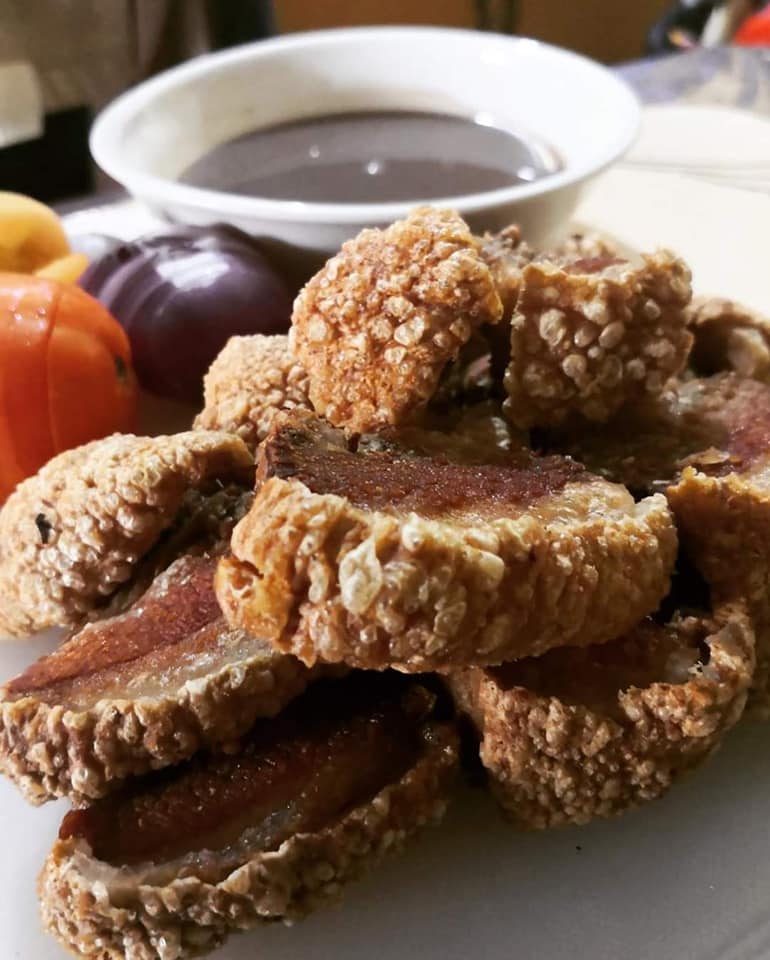
Photo source: https://www.facebook.com/famousviganbagnet/photos/1372128949650271
3. It originated from the Ilocos1 region2 of the Philippines, where it is locally called chicharon3.
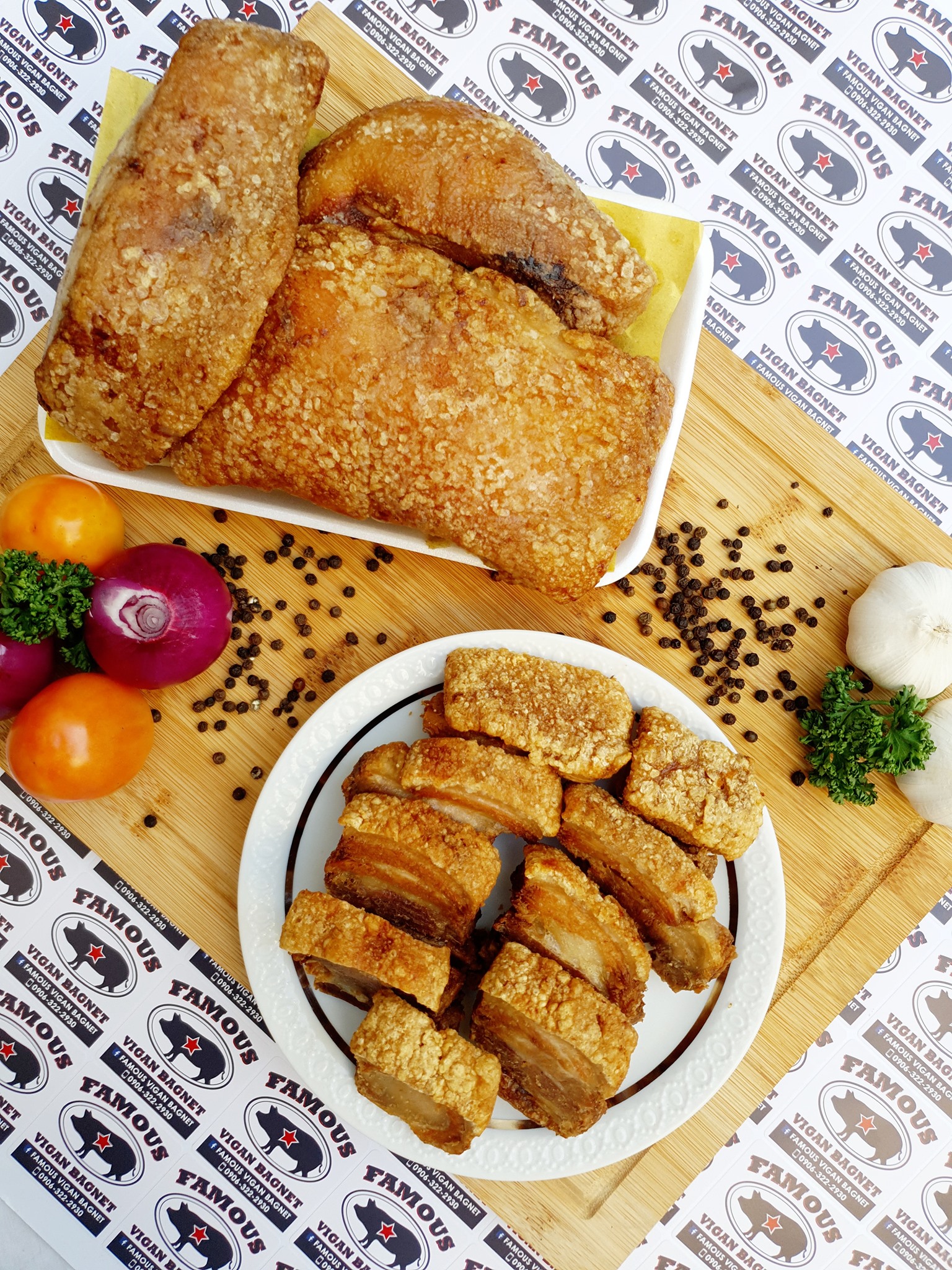
Photo source: https://www.facebook.com/famousviganbagnet/photos/a.294969537366223/1374722286057604
4. The municipality4 of Narvacan in the province5 of Ilocos Sur is said to be the original bagnet-makers, and on December 13, 2010. instituted the Bagnet Festival. The succeeding annual celebrations of this month-long festival are held from the middle of November till the 2nd week of December,
It has been said that the Spanish-Mexican conquistador6 Captain Juan de Salcedo7 discovered Narvacan in 1576 and the natives served him Bagnet. The recipe and technique to make this crispy dish is considered an heirloom and is passed down through several generations in Narvacan.
5. Bagnet can be eaten as is, or with white rice.
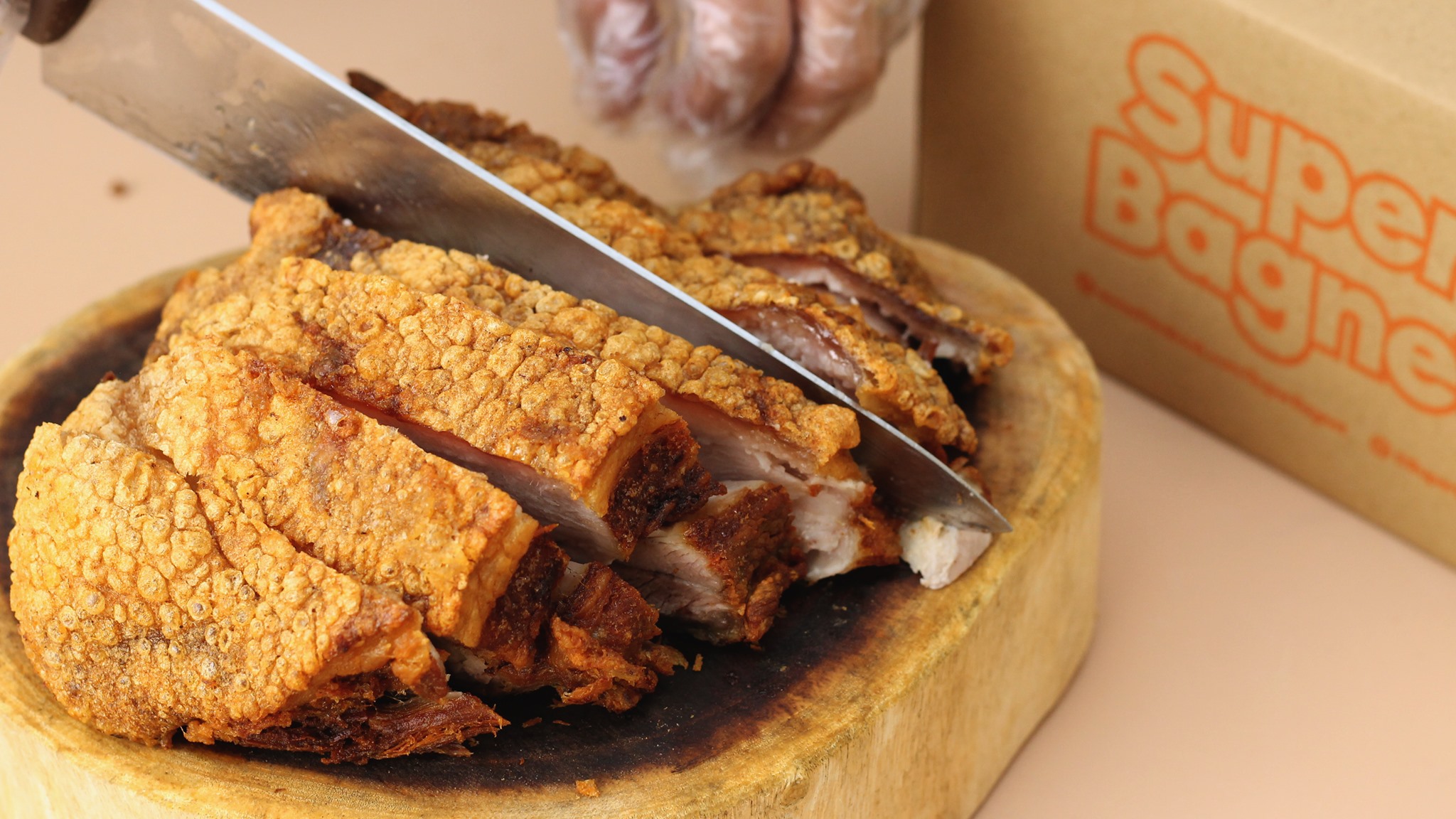
Photo source: https://www.facebook.com/superbagnet/photos/a.259433441218560/1090479124780650
6. It is traditionally dipped in sukang iloko8 (Ilocano vinegar) or bagoong monamon9 (Ilocano fermented salted anchovies).
7. It can also be added to other Filipino dishes like Pinakbet10 and Dinardaraan11.
8. It is similar to a Tagalog12 dish called Lechon Kawali13.
The information was obtained from https://www.manilatimes.net/2011/01/21/lifestyle-entertainment/life-times/its-the-firstbagnet-festival/647772, https://www.facebook.com/prubandlevarl/posts/ilocano-bagnet-or-simply-known-as-bagnet-is-a-boiled-air-dried-then-deep-fried-s/321455435239128/ and the Wikipedia page “Bagnet”14.
Now, Tita S will briefly comment about Bagnet.
Personally, it is difficult to resist Bagnet because of its super crispy appeal. What makes it special is the delightfully crunchy chicharon3 skin which I dip in spicy vinegar.
I have not had Bagnet for the longest time but I recall that I also enjoyed it along with boiled eggplant and okra with bagoong15 on the side.
This is not a sponsored post. I just want my readers to know more about Philippine delicacies.
The photos used in the cover picture-collage were obtained from https://www.facebook.com/superbagnet/photos/
Did you find this post informative? I would like to hear your comment/s regarding Bagnet.
See other interesting posts in this category (Pinoy Delights) and other categories – SCapades and Smart Travelers – Foreign Travelers Ask, Now You Know, and Say, Say, Say. Happy reading, and I hope that you will appreciate what I shared and some of the featured destinations will be part of your future travel plans!
Remember to share this post with your Facebook friends, and to follow me by clicking on the bottom right corner of your device. And, do not forget to like this post. Thank you.
– – – – – – – – – – – – – – – – – – – – – – – – – –
The following terms are defined for interested readers, especially those with “Senior-Moments”, those not familiar with Filipino terms, and those too busy or lazy to Google such terms:
1The Ilocos Region, or Region 1, is an administrative region in the northwestern section of Luzon, the northernmost part of the Philippines. It is bordered by the Cagayan Valley to the northeast and southeast, the South China Sea to the west, Cordillera Administrative Region to the east, and Central Luzon to the south. This region is composed of 4 provinces5: Ilocos Norte, Ilocos Sur, La Union, and Pangasinan. Its regional center is the city of San Fernando, in La Union. The information was obtained from the Wikipedia page “Ilocos Region”.16
2A region is the first-order administrative division in the Philippines. There are 17 regions in the Philippines, based on geographical, cultural and ethnological characteristics. It is further subdivided in provinces5, composed of cities and minicipalities4, which in turn, are divided into barangays17 (district or village). The information was obtained from the Wikipedia page “Regions of the Philippines.”18
See a related post: Foreign Seniors Ask: WHAT ARE THE REGIONS OF THE PHILIPPINES?
3Chicharon, or pork crackling, is a popular snack or pulutan19 of Filipinos. It is basically deep fried, dried and salted pork rind. It is often dipped in spicy vinegar, or a dip composed of soy sauce, coconut vinegar, chopped garlic and labuyo20 (chili peppers). It can also be enjoyed with bagoong15 (fermented, salted anchovies), lechon sauce21, or atchara22. It is also used as a topping of native vegetable and noodle dishes.
A variation is made from chicken skin and is called chicharong manok. There is also chicharong bulaklak, made from a pig’s mesentery23. In the province5 of Cagayan, carabao24 hide is made into carabao chicharon. A healthier variant is tuna- or tilapia25-skin chicharon.
The information was obtained from the Wikipedia page “Chicharron.”26
4A municipality is a small, single urban administrative division, or local government unit (LGU)27, in the Philippines which has corporate status and powers of self-government or jurisdiction as granted by law. It is a unit under a province5, subdivided into barangays17, and is called town, or bayan. In the Philippines, a municipality is headed by a mayor, a vice mayor and members of the Sangguniang Bayan (legislative branch). The information was obtained from Wikipedia page “Municipalities of the Philippines.”28
5A province is the primary administrative and political division in the Philippines. It is the second-level administrative sub-division of a region2. There are 81 provinces (called lalawigan) in the Philippines. Each province is governed by an elected legislature called the Sangguniang Panlalawigan and by an elected governor. All these were obtained from Wikipedia page “Provinces of the Philippines.”29
See a related post: Foreign Seniors Ask: WHAT ARE PROVINCES IN THE PHILIPPINES?
6A conquistador was a knight, soldier, and explorer of the Spanish and Portuguese Empires during the Age of Discovery or Exploration, from the 15th – 18th centuries.
Conquistador is the Spanish and Portuguese term for “conqueror”. A conquistador would sail from Europe to the Americas, Oceania, Africa and Asia, conquering territory and opening trade routes. The information was obtained from the Wikipedia page “Conquistador”.30
7Juan de Salcedo (1549 – 1576) was a Spanish-Mexican conquistador6, born in Mexico. He was the grandson of Miguel Lopez de Legazpi (the first Governor-General of the Spanish East Indies) and a brother of Felipe de Salcedo (a Spanish explorer who was a member of his grandfather’s expedition to the East Indies and the Pacific).
At the age of 15, he joined the Spanish military in 1564 to explore the East Indies and the Pacific. He was one of the soldiers who accompanied the Spanish colonization of the Philippines in 1565. He, along with Martin de Goiti, also led an army of about 300 Spanish and Mexican soldiers and 600 Visayan allies, in their conquest of Islamic Manila (which was then under the Sultanate of Brunei).
In 1574, with 300 Mexican and Spanish soldiers and 300 Filipino Militia, he fought Limahong’s 6,500 Chinese pirates and Japanese Ronins. He died at the age of 27, in 1576, and his body was interred at the San Agustin Church in Intramuros, in the city of Manila.
The information was obtained from the Wikipedia pages “Juan de Salcedo”31, “Miguel Lopez de Legazpi”32 and “Felipe de Salcedo”33.
8Sukang Iloko is an opaque vinegar made from naturally fermented sugar cane in the Ilocos1 region2 of the Philippines. It has a strong, acidic aroma, and is used as a condiment, dip, or food preservative.34
9Bagoong monamon, bagoong monamon-dilis, or bugguong munamon, in Ilocano, is a condiment and common ingredient in Ilocano cuisine which made by fermenting salted anchovies (called monamon or munamon in Ilocano). For foreigners, its strong fishy smell could be repulsive. It is marketed either with bits of fermented fish (to make the Ilocano vegetable dish called Dinengdeng), or “boneless” (without fermented fish), sold in bottles. The information was obtained from the Wikipedia page “Bagoong monamon”.35
10Pinakbet, pakbet, or pinak bet, is an indigenous Filipino dish originating from the northern regions of the Philippines. It is made of mixed vegetables (usually bitter melon, eggplant, okra, string beans, winged beans, tomato, chili peppers), spiced with garlic, ginger and onions, steamed or sauteed in fish or shrimp sauce.. Meat may be added. The Tagalog version includes squash. The word is the contracted form of the Ilokano (a northern Philippine dialect) word pinakebbet, meaning “shrunk” or “shriveled”. The information was obtained from the Wikipedia page “Pinakbet”.36
11Dinardaraan is a savory, almost dry, Ilocano stew made of pork offal, blood, and/or meat. It is cooked with garlic, onion, broth, vinegar, and siling haba37, seasoned to taste with salt and pepper. It could be topped with deep-fried pork intestine cracklings. It is called the Ilocano dinuguan. See my post about dinuguan: ___
12Tagalog refers to the second largest ethnolinguistic group in the Philippines (after the Visayan people), numbering around 30 million, with most of them inhabiting Metro Manila, the Calabarzon region in southern Luzon, the islands of Marinduque and Mindoro in Mimaropa, as well as a plurality in the provinces5 of Aurora, Bataan, Bulacan, Nueva Ecija and Zambales in Central Luzon. The information was obtained from Wikipedia page “Tagalog (people).”38
13Lechon kawali, or lechon de carajay, is a brown, deep-fried, crispy, Tagalog dish made of seasoned pork belly slabs. It is usually accompanied with a dipping sauce like lechon sauce21 or toyomansi (soy sauce with Philippine lime). The information was obtained from the Wikipedia page “Lechon kawali”.39
14“Bagnet,” accessed November 3, 2020, https://en.wikipedia.org/wiki/Bagnet
15Bagoong is a Philippine condiment, partially or completely, made of fermented fish or krill40, and oysters, clams and even fish/shrimp roe, and salt. The by-product of fermentation is the resulting yellowish liquid which is skimmed and called patis (fish sauce).
There are several kinds: bagoong isda (fermented fish – sardines, anchovies, the fry of larger fish), bagoong alamang41 (fermented krill), as well as the rarer bagoong macabebe (fermented oysters) and bagoong sisi (fermented clams).
The preparation of bagoong varies regionally in the Philippines. See https://en.wikipedia.org/wiki/Bagoong for more information.
The information was obtained from the Wikipedia page “Bagoong”.42
16“Ilocos Region,” accessed April 17, 2018, https://en.wikipedia.org/wiki/Ilocos_Region
17A barangay is the smallest administrative division in the Philippines, headed by a barangay captain, aided by a Sangguniang Barangay (Barangay Council). It is the native Filipino term for a district or village. It was formerly called a barrio. In a metropolitan area, a barangay is an inner city neighborhood, a suburb, or a suburban neighborhood. The word barangay originated from the term balangay, a kind of boat used by a group of Austronesian people who migrated to the Philippines. A number of barangays grouped together is called a district. The information was obtained from Wikipedia page “Barangay.”43
18“Regions of the Philippines,” accessed April 17, 2018, https://en.wikipedia.org/wiki/Regions_of_the_Philippines
19Pulutan is the Filipino term for an appetizer taken with alcoholic beverages.
20Siling labuyo, or simply labuyo, is a small chili pepper that developed in the Philippines after the Columbian Exchange44. It belongs to the species Capsicum frutescens and is characterized by triangular, very pungent fruits which grow pointing upwards. Siling labuyo is a Tagalog term meaning “wild chili”. The information was obtained from Wikipedia page “Siling labuyo.”45
21Lechon sauce (sarsa ng lechon) is a condiment traditionally made from mashed pork liver, vinegar, brown sugar, bread crumbs, garlic, and onion, and seasoned with salt and pepper. It is the favorite sauce for lechon (roasted pig) prepared in Luzon (the northern group of islands of the Philippines). Liver spread can substitute for mashed pork liver. The information was obtained from Wikipedia page “Lechon.”46
22Achara, atchara, or atsara, is a pickled side dish, or accompaniment of fried or grilled foods, in the Philippines. It is made of grated unripe papaya, carrot and onion slices, julienned garlic, bell pepper strips, along with vinegar, syrup and salt. Raisins may be added.
23The mesentery is a thin tissue or membrane of a pig filled with blood vessels, which holds the small intestine in place.47
In the Philippines, it is called ruffle fat, and enjoyed as a pulutan19, called Chicharon Bulaklak made by boiling with salt, peppercorns and bay leaves, salted, then deep fried.
24The carabao is a domestic swamp-type water buffalo (Bubalus bubalis) native to the Philippines, according to the Wikipedia page “Carabao”.48
25Tilapia is a freshwater fish which inhabits shallow streams, ponds, rivers and lakes in temperate countries. In the Philippines, it is commonly called pla-pla, and several species of tilapia are commercially grown in major lakes and rivers like Laguna de Bay, Taal Lake and Lake Buhi. The information was obtained from the Wikipedia page “Tilapia”.49
26“Chicharron,” accessed November 3, 2020, https://en.wikipedia.org/wiki/Chicharron
27A local government unit (LGU) in the Philippines is divided into 3 levels: provinces5, cities, municipalities4, and, barangays17, according to Wikipedia page “Local government in the Philippines”.50
28“Municipalities the Philippines,” accessed April 2, 2018, https://en.wikipedia.org/wiki/Local_government_in_the_Philippines
29“Provinces of the Philippines,” accessed April 2, 2018, https://en.wikipedia.org/wiki/Provinces_of_the_Philippines
30“Conquistador,” accessed July 9, 2018, https://en.wikipedia.org/wiki/Conquistador
31“Juan de Salcedo,” accessed November 3, 2020, https://en.wikipedia.org/wiki/Juan_de_Salcedo
32“Miguel Lopez de Legazpi,” accessed November 3, 2020, https://en.wikipedia.org/wiki/Miguel_Lopez de Legazpi
33“Felipe de Salcedo,” accessed November 3, 2020, https://en.wikipedia.org/wiki/Felipe_de_Salcedo
34https://recipes.fandom.com/wiki/Sukang_iloko
35“Bagoong monamon,” accessed November 3, 2020, https://en.wikipedia.org/wiki/Bagoong_monamon
36“Pinakbet,” accessed November 3, 2020, https://en.wikipedia.org/wiki/Pinakbet
37Siling haba is a kind of long chili which is light green in color and belongs to the species Capsicum annuum. It is mildly spicy and is commonly used in Filipino dishes, especially in Sinigang (a sour soup), Paksiw (meat or fish in a vinegar broth), Dinuguan (Pork Blood Stew), and Kinilaw (Philippine ceviche). It is also called espada, finger chili, green chili, long pepper, and siling mahaba, siling pangsigang, siling Tagalog. The information was obtained from the Wikipedia page “Siling haba”.51
38“Tagalog people,” accessed January 15, 2018, https://en.wikipedia.org/wiki/Tagalog_people
39“Lechon kawali,” accessed November 3, 2020, https://en.wikipedia.org/wiki/Lechon_kawali
40Krill are small crustaceans of the order of Euphausiacea, and are found in all the world’s oceans. The term comes from the Norwegian word krill, meaning “small fry of fish”, which is often attributed to species of fish. Near the bottom of the ocean’s food chain, they feed on phytoplankton and even zooplankton, and are the main source of food for many larger animals (e.g., whales, seals, penguins, squids and fishes), especially near the surface of the water at night, and in deeper waters during the day. Most are caught for aquaculture and aquarium feeds, as bait in sport fishing, or in pharmaceutical industry. In the Philippines, krill is known as alamang and used to make a salty paste called bagoong15. The information was obtained from the Wikipedia page “Krill”.52
41Bagoong alamang is a kind of bagoong15 prepared by initially cleaning the krill40 (alamang) thoroughly then washing it in a weak (10%) brine solution. The krill is then mixed with salt in a 25% salt to 75% krill ratio by weight.
The mixture is kept covered, inside large earthen fermentation jars (tapayan in Tagalog and Visayan, or burnay in Ilocano) and left to ferment for 1 – 3 months, with occasional stirring to make sure that the salt is evenly spread.
Patis, the liquid on top, is skimmed, leaving the fermented krill, which is bagoong alamang. At this point, it is usually pale grey to white in color. This bagoong is traditionally colored pink or red through the addition of angkak53.
It is called uyap or alamang in southern Philippines, aramang in Ilocos and parts of Northern Luzon, and ginamos or dayok in Western Visayas.
The information was obtained from the Wikipedia page “Bagoong”.42
42“Bagoong,” accessed April 2, 2018, https://en.wikipedia.org/wiki/Bagoong
43“Barangay,” accessed April 2, 2018, https://en.wikipedia.org/wiki/Local_government_in_the_Philippines
44The Columbian Exchange, or the Columbian Interchange, was the widespread transfer of plants, animals, culture, (free and enslaved) human populations, technology, diseases, and ideas between the Americas and the Old World in the 15th and 16th centuries. It is named after Christopher Columbus, and is related to European colonization and trade following his 1492 voyage. This term was first used in 1972 by the American historian Alfred W. Crosby in his environmental history book “The Columbian Exchange”. It was rapidly adopted by other historians and journalists. The information was obtained from Wikipedia page “Columbian Exchange”.54
45“Siling labuyo,” accessed November 3, 2020, https://en.wikipedia.org/wiki/Siling_labuyo
46“Lechon,” accessed November 3, 2020, https://en.wikipedia.org/wiki/Lechon
47https://learning-center.homesciencetools.com/article/pig-dissection-project/
48“Carabao,” accessed April 2, 2018, https://en.wikipedia.org/wiki/Carabao
49“Tilapia,” accessed December 12, 2018, https://en.m.wikipedia.org/wiki/Tilapia
50“Local government in the Philippines,” accessed April 2, 2018, https://en.wikipedia.org/wiki/Local_government_in_the_Philippines
51“Siling haba,” accessed November 3, 2020, https://en.wikipedia.org/wiki/Siling_haba
52“Krill,” accessed April 2, 2018, https://en.wikipedia.org/wiki/Krill
53Angkak, red yeast rice, red rice koji, red fermented rice, red kojic rice, red koji rice, or anka, is a bright reddish purple fermented rice which acquired its color from the inoculation of the species of red mold (Monascus purpureus). Note that koji is the Japanese term for “grain or bean overgrown with a mold culture”.
Angkak is the Filipino term for red yeast rice and is widely used in the Philippines to traditionally color and preserve certain dishes like bagoong alamang41 (fermented shrimp), burong isda (fermented rice and fish), and balao-balao (fermented rice and shrimp).
The information was obtained from the Wikipedia page “Red yeast rice”.55
54“Columbian Exchange,” accessed November 3, 2020, https://en.wikipedia.org/wiki/Columbian_exchange
55“Red yeast rice,” accessed April 2, 2018, https://en.wikipedia.org/wiki/Red_yeast_rice


